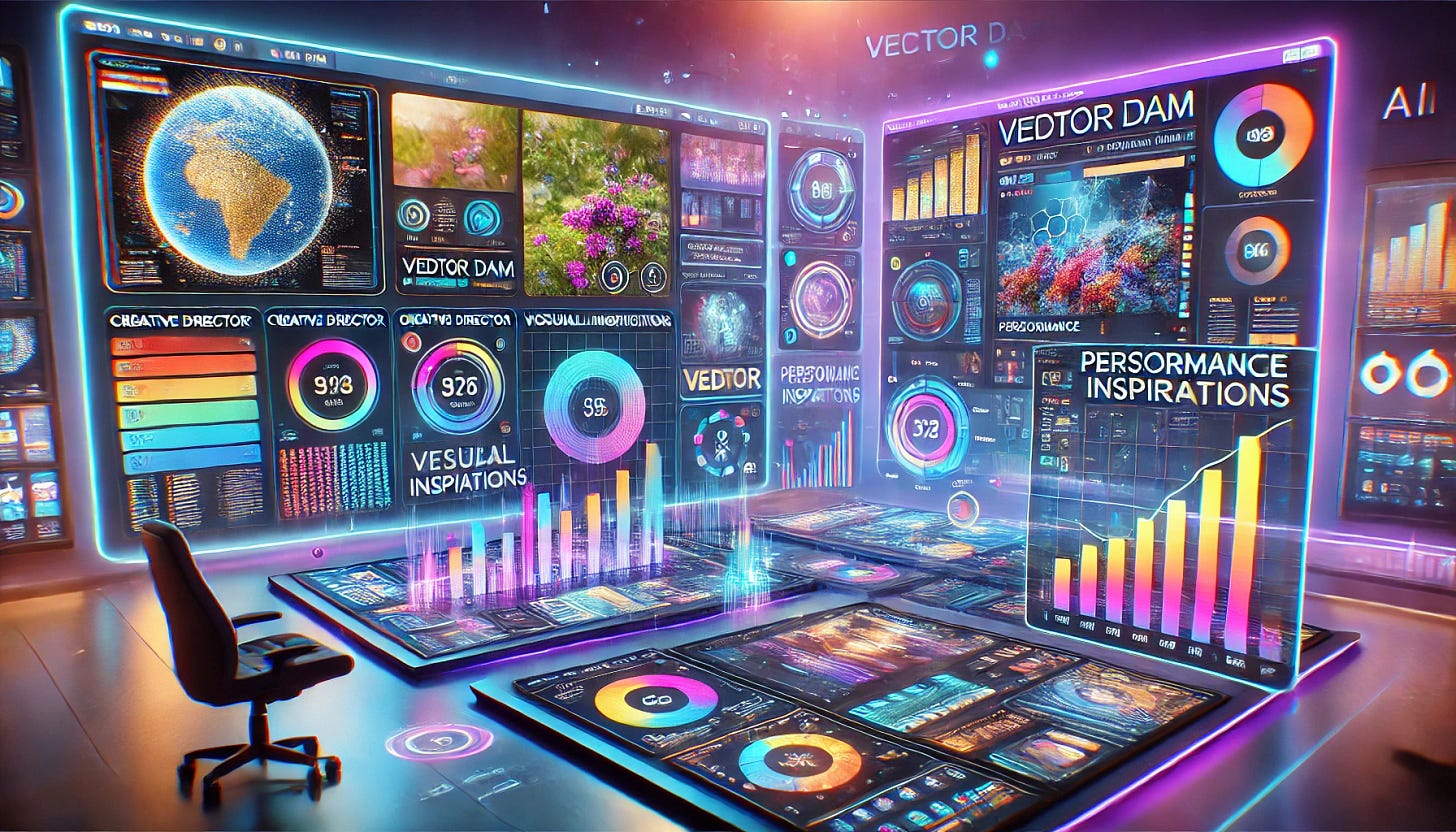The Future of The Vector DAMS
Vector Database-Enhanced Digital Asset Management
In the age of intelligent technology, The Vector DAM isn't just about managing assets; it's about unlocking the full potential of creativity and innovation, transforming every search into a discovery and every idea into a master plan.
Exploring Digital Asset Management (DAM) in the context of vector databases and vector search for generative AI involves understanding how these technologies can enhance asset retrieval and management capabilities, and what impact they might have on the DAM industry. Here’s a breakdown:
Vector Databases and Vector Search
Vector Databases: Vector In
Store data as high-dimensional vectors.
Excel at handling complex data types like images, audio, and text embeddings from AI models.
Facilitate similarity search, making them ideal for tasks requiring nuanced understanding of data, such as facial recognition, sentiment analysis, and image similarity.
Vector Search:
Uses vectors to find and rank the most similar items within a database.
Allows for more accurate and context-aware searches compared to traditional keyword-based methods.
Enhances user experience by providing more relevant search results, particularly for media-rich content typical in DAM systems.
Impact on DAM Systems
Enhanced Search Capabilities:
Vector search can significantly improve the ability to find specific assets within a large repository by understanding context and content, not just metadata.
This is particularly useful for creative industries where finding similar styles, themes, or elements in images and videos is crucial.
Generative AI Integration:
Generative AI models can be trained on the assets within a DAM system to create new content, enhancing creativity and production capabilities.
These models require sophisticated search and retrieval mechanisms to access relevant training data, where vector databases play a pivotal role.
Shift in the DAM Industry
Adoption of Vector Technologies:
Some forward-thinking DAM vendors may start integrating vector databases and vector search to stay competitive.
This shift can be gradual, starting with hybrid systems that combine traditional relational databases with vector search capabilities.
Potential Disruption:
New entrants leveraging vector databases from the ground up may disrupt established DAM vendors.
These disruptors can offer superior search functionality and generative AI integration out of the box, appealing to organizations needing advanced capabilities.
Key Considerations for DAM Vendors
Integration Costs:
Evaluate the cost and complexity of integrating vector databases with existing DAM systems.
Consider partnerships with specialized vendors providing vector search solutions.
Performance and Scalability:
Ensure that the new technology can handle large-scale data typical of DAM systems without compromising performance.
Optimize infrastructure for high-dimensional data processing.
User Experience:
Design intuitive interfaces that leverage vector search for enhanced user interaction.
Educate users on the benefits and usage of the new search capabilities.
Competitive Analysis:
Monitor the market for emerging trends and competitors using vector databases.
Stay agile and be prepared to innovate continuously.
The shift to vector databases and vector search in DAM systems is inevitable as organizations demand more intelligent and efficient ways to manage and retrieve their digital assets. DAM vendors need to strategically plan their adoption of these technologies or risk being disrupted by more agile and technologically advanced newcomers. This evolution not only enhances asset management but also opens new avenues for integrating generative AI, further revolutionizing the industry.
The Future of The Vector DAM
1. Hyper-Intelligent Search and Retrieval
Scenario: In 2028, creative teams at a global advertising firm access their DAM system. Instead of traditional keyword searches, they rely on advanced vector search algorithms. A designer uploads a sketch, and the system instantly retrieves a curated list of assets—images, videos, music files—that match the style, theme, and emotional tone of the sketch.
Impacts:
Efficiency: Searches that once took hours are completed in seconds.
Creativity: Teams are inspired by finding unexpected yet relevant content.
Collaboration: Cross-functional teams work seamlessly, using the same intuitive search tools.
2. Seamless AI Integration for Content Creation
Scenario: Marketing departments use generative AI models integrated with their Vector DAM. A campaign manager inputs basic parameters—target audience, key message, and campaign tone. The AI generates various drafts of promotional content, including social media posts, video scripts, and graphic designs, all based on assets within the DAM.
Impacts:
Creativity: AI-powered content creation leads to innovative campaigns.
Speed: Campaign development cycles are drastically shortened.
Personalization: Tailored content is generated for different audience segments with ease.
3. Predictive Analytics and Insights
Scenario: Product managers receive predictive analytics from their Vector DAM, offering insights into asset usage trends and content performance. They can see which types of assets resonate most with their audience and predict future content needs.
Impacts:
Strategy: Data-driven decisions enhance marketing strategies.
Efficiency: Resources are allocated based on predictive insights, reducing waste.
Growth: Brands adapt quickly to market trends, staying ahead of competitors.
4. Automated Rights Management and Compliance
Scenario: A multinational corporation manages thousands of digital assets across various markets. The Vector DAM includes automated rights management, ensuring that only compliant assets are used in each region. The system alerts users if an asset's usage rights are about to expire or if it violates local regulations.
Impacts:
Compliance: Reduced risk of legal issues with automated checks.
Efficiency: Teams focus on creativity rather than administrative tasks.
Cost: Lower legal and compliance-related costs.
5. Enhanced User Experience and Customization
Scenario: The Vector DAM offers personalized interfaces for different user roles. Creative directors see mood boards and visual inspirations, while marketers view performance dashboards and campaign analytics. The system learns individual preferences and adjusts the interface and recommendations accordingly.
Impacts:
Usability: Tailored experiences increase user satisfaction.
Productivity: Users access the most relevant tools and insights quickly.
Adoption: Higher adoption rates across the organization due to user-friendly design.
Conclusion
The future of The Vector DAM is a transformative vision where advanced technologies streamline workflows, enhance creativity, and provide deep insights. By leveraging vector databases and AI, organizations can stay ahead of the curve, offering unparalleled user experiences and driving innovation.



